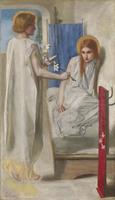Items
Tag
Pre-Raphaelite
-
 "Ecce Ancilla Domini" (The Annunciation)_Dante Gabriel Rossetti Inspired by the work of early Renaissance artists such as Botticelli (1445-1510) and Fra Angelico (1387-1455), Rossetti sought in this work a radical reinterpretation of the Annunciation. Traditionally the Virgin was depicted in studious contemplation, reading a missal at a prie-dieu; but here Rossetti shows her rising awkwardly from a low bed, as if disturbed from sleep, while the Angel Gabriel presents her with a white lily. Both figures are dressed in white, a symbol of the virgin's purity, and the angel's role as the messenger of god is emphasised by the small white dove hovering beside him, signifying the presence of the holy spirit. Rossetti used several sitters for his figures, including his brother, William Michael, for the Angel and his sister, Christina, for the Virgin. A companion piece showing the Virgin's death was planned, but never begun. This partly explains the tall narrow shape of the picture, which was intended as part of a diptych. Rossetti intentionally restricted his palette almost entirely to white and the three primaries. The colour blue, symbolic of heaven, is traditionally associated with the Virgin and red symbolises the blood of Christ. Rossetti even sought a red-haired model for the Virgin's head. The composition is carefully thought out: the vertical division of space, made by the blue hanging and the edge of the bed, falls almost on the Golden Section. The dove and the lily, with one bud still to break, move across this division and are the instruments of conception. Rossetti has written the date, 'March', at the bottom of the canvas, perhaps to signify the month in which the Feast of the Annunciation is held. The original frame was also inscribed with Latin mottoes, copied from a brass rubbing owned by a fellow member of the Pre-Raphaelite Brotherhood, F.G. Stephens (1828-1907).
"Ecce Ancilla Domini" (The Annunciation)_Dante Gabriel Rossetti Inspired by the work of early Renaissance artists such as Botticelli (1445-1510) and Fra Angelico (1387-1455), Rossetti sought in this work a radical reinterpretation of the Annunciation. Traditionally the Virgin was depicted in studious contemplation, reading a missal at a prie-dieu; but here Rossetti shows her rising awkwardly from a low bed, as if disturbed from sleep, while the Angel Gabriel presents her with a white lily. Both figures are dressed in white, a symbol of the virgin's purity, and the angel's role as the messenger of god is emphasised by the small white dove hovering beside him, signifying the presence of the holy spirit. Rossetti used several sitters for his figures, including his brother, William Michael, for the Angel and his sister, Christina, for the Virgin. A companion piece showing the Virgin's death was planned, but never begun. This partly explains the tall narrow shape of the picture, which was intended as part of a diptych. Rossetti intentionally restricted his palette almost entirely to white and the three primaries. The colour blue, symbolic of heaven, is traditionally associated with the Virgin and red symbolises the blood of Christ. Rossetti even sought a red-haired model for the Virgin's head. The composition is carefully thought out: the vertical division of space, made by the blue hanging and the edge of the bed, falls almost on the Golden Section. The dove and the lily, with one bud still to break, move across this division and are the instruments of conception. Rossetti has written the date, 'March', at the bottom of the canvas, perhaps to signify the month in which the Feast of the Annunciation is held. The original frame was also inscribed with Latin mottoes, copied from a brass rubbing owned by a fellow member of the Pre-Raphaelite Brotherhood, F.G. Stephens (1828-1907). -
 "Autumn Sunshine"_George Cochran Lambdin George Cochran Lambdin painted this work while living in Philadelphia's Germantown section,an area famed in the late nineteenth century for its gardens. Lambdin turned his attention to paintings of flowers in 1870, probably inspired by the English Pre-Raphaelites, who believed that a closer study of nature resulted in paintings that were more spiritually truthful. In Autumn Sunshine, Lambdin did not use the traditional composition of a vase of flowers on a tabletop. Instead, his painting of potted plants on the floor of a greenhouse captures the flowers as they are still growing, creating a more natural image. The soft tones of yellow and pink emphasize the delicate texture of the chrysanthemum's petals, while the dead leaves, together with the thin vine in the background, enhance the feeling of having captured a fleeting moment in nature.
"Autumn Sunshine"_George Cochran Lambdin George Cochran Lambdin painted this work while living in Philadelphia's Germantown section,an area famed in the late nineteenth century for its gardens. Lambdin turned his attention to paintings of flowers in 1870, probably inspired by the English Pre-Raphaelites, who believed that a closer study of nature resulted in paintings that were more spiritually truthful. In Autumn Sunshine, Lambdin did not use the traditional composition of a vase of flowers on a tabletop. Instead, his painting of potted plants on the floor of a greenhouse captures the flowers as they are still growing, creating a more natural image. The soft tones of yellow and pink emphasize the delicate texture of the chrysanthemum's petals, while the dead leaves, together with the thin vine in the background, enhance the feeling of having captured a fleeting moment in nature.